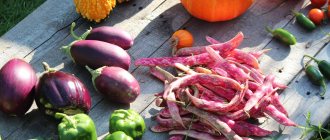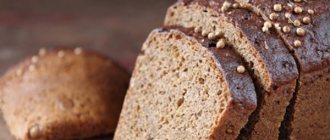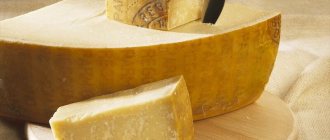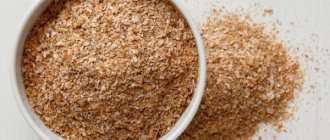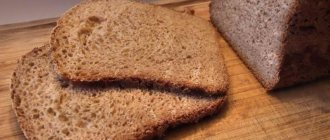Hello, dear readers! Cucumber is a unique vegetable that many people love. It fills the body with energy, without causing any harm to the figure, because... its main component is water. People are accustomed to using it in a variety of forms and even adding it to many dishes. Let's figure out what it actually is, and also consider the calorie content of cucumber in different forms.
The popularity of cucumbers is explained by their unpretentiousness to growing conditions, as well as their fairly low price, which is combined with a pleasant taste and a lot of benefits for humans.
Varieties and types of vegetables
| By type of reproduction | |
| Partnerocarpic (hybrid) | The fruits set without pollination and have no seeds. |
| Self-pollinating (hybrid) | They are pollinated by stamens and pistils. |
| Bee-pollinated | They reproduce only through pollination by bees. |
| To size | |
| Pikuli | fruits that have just begun to set; length - from 3 to 5 cm. |
| Gherkins | Longer fruits (from 5 to 9 cm). |
| Salad | Long and crispy fruits with smooth skin; grown specifically for adding to salads or as a snack. |
| For pickling | Cucumbers are small in size and of suitable hardness for rolling into jars. |
| Universal | The fruits can be consumed both fresh and canned. They have a long shelf life. |
There are also varieties of cucumbers depending on the growing conditions (open or closed ground, in a greenhouse or outdoors).
There are a lot of varieties, the most popular among them are:
- “Bush” - has hard, pimply fruits; not susceptible to diseases and resistant to adverse weather conditions, grown in open ground.

- “Tom Thumb” - grown in a greenhouse; It is characterized by a rapid growth rate and ripeness of fruits, and is not susceptible to disease. It can produce both tasty gherkins and longer fruits. Most often, this variety is used for pickling and canning.
- “Benefit F1” - the fruits ripen 45-50 days from the beginning of the first shoots. Cucumbers are medium in size, weigh 100-120 g and have a bumpy surface. They are universal.
- “Nezhinsky” - cucumbers ripen late, grow slightly elongated with large pimples. Grown in open ground.
- “Vyaznikovsky” is a drought-resistant variety and most suitable for pickling; does not have high yield.
- “Gypsy” - suitable for growing both in open ground and in greenhouses. The cucumbers are moderately hard and crispy.
- “Arctic” - have a fresh, rich taste and can be grown in outdoor and greenhouse conditions.
- “Tchaikovsky” is an early ripening variety grown in greenhouse conditions. Resistant to diseases.
- “Cupid” has small, moderately hard fruits. It is a universal species, suitable for growing in various conditions.
Cultivation
Today, cucumbers are cultivated in two ways: seedlings and seeds.
In the first case, the harvest is harvested in early June, and in the second - in mid-July. Growing cucumbers using the seedling method:
The first stage of pre-sowing preparation begins with warming up. To do this, full-sized bones are kept for 4 hours in the oven at a temperature of 45 degrees (with constant stirring). Cucumber seeds can be heated using a simpler method by hanging them in gauze bags near heating devices (1.5 months before sowing). After this, the raw materials are placed for an hour in a solution of potassium permanganate or garlic pulp (diluted 1:3). Then the disinfected seeds are placed in cotton bags and dipped in a nutrient mixture (of nitrophoska, wood ash and water). After 12 hours, the bones are washed with clean water and placed on a slightly damp cloth to swell (for 1-2 days). At the same time, it is important to ensure that they do not germinate, but only slightly “hatch”. After this, the planting material is placed in the refrigerator for a day.
Remember, hybrid varieties of cucumbers do not require pre-sowing treatment.
To moisten the soil, crops can be sprayed with a spray bottle. If it is necessary to slow down the growth of the seedling, the intensity of watering is halved.
Calorie content, BJU
Cucumber, whose benefits and harm to the body depend on its chemical composition, contains about 95% water.
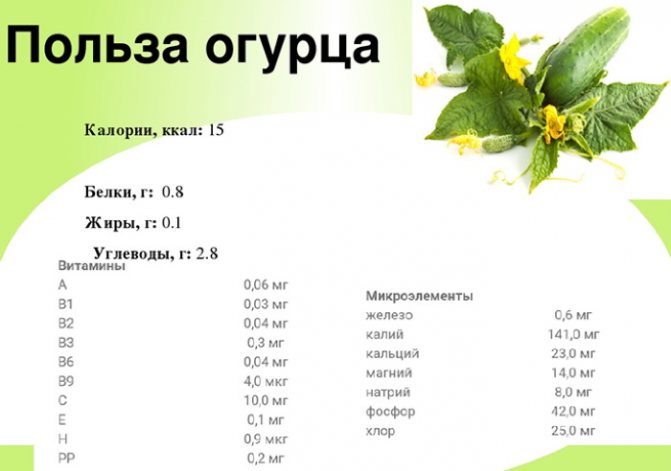
The remaining 5% comes from BJU and other nutrients:
| Nutrient | Content per 100 g |
| Squirrels | 0.7 g |
| Fats | 0.1 g |
| Carbohydrates | 2.4 g |
| Cellulose | 1 g |
| Ash | 0.5 g |
| Pectins | 0.4 g |
| Organic acids | 0.1 g |
| Starch | 0.1 g |
Cucumbers also contain a large amount of vitamins, micro- and macroelements. The vegetable is especially rich in potassium, which is necessary for the normal functioning of the cardiovascular system. The calorie content of cucumbers per 100 g is 15 Kcal. For different varieties and types of cucumbers, the calorie content and chemical composition may vary slightly.
Carbohydrates, proteins and fats in vegetables, their calorie content
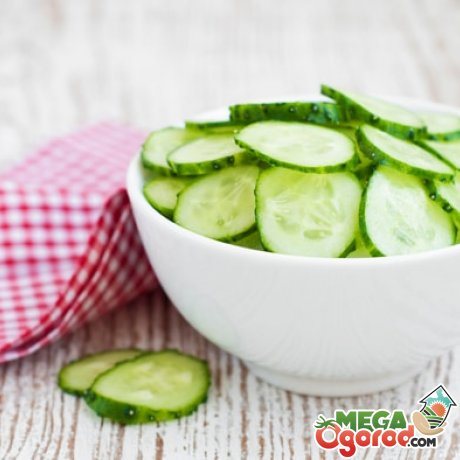
When participating in activities aimed at losing weight, one should not forget that cucumber effectively fights excess pounds. A fresh vegetable contains from 11 to 15 kilocalories. But when the product is marinated, their quantity increases slightly. Even in cucumber salads with sour cream, the calorie content is not too high to refuse them.
Due to its low calorie content and ability to saturate the human body, cucumber is indispensable in weight loss diets.
Zelentsy contains proteins - no more than 0.8 grams. The amount of fat is minimal, not even 0.1 grams. But carbohydrates predominate in vegetables - 2.5-3 grams per 100 grams of product. But it’s interesting that cucumbers prevent carbohydrates from being converted into fats and delay the process. Salted and pickled vegetables cannot do this.
Benefit
The rich chemical composition and very low calorie content allow cucumbers to be classified as dietary products. On a diet, they can be consumed in large quantities. Due to the presence of fiber, the product cleanses the gastrointestinal tract and causes a feeling of fullness, thereby promoting weight loss.
And the water contained in cucumbers is different from ordinary water - it is purer and more structured and perfectly fills the body with moisture.
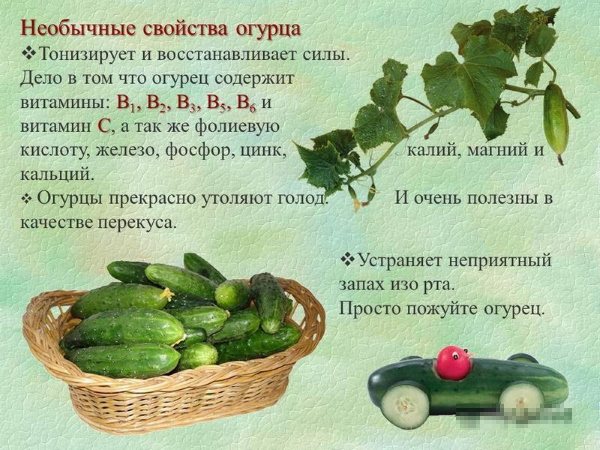
Cucumber. Benefits and harms for the body. It has much more benefits.
The vegetable also has the following beneficial properties:
- Normalizes digestion . The fiber in cucumbers enhances intestinal motility and gently relieves constipation.
- Has a diuretic effect . Due to their high water content, vegetables gently remove excess water from the body and eliminate swelling.
- Cleanses the body . When it enters the body, cucumber juice dissolves toxins and wastes, as well as heavy metal salts and removes them through the kidneys.
- Is a source of vitamins and minerals . Daily consumption of cucumbers (pure or as part of salads, smoothies) will help saturate the body with the necessary nutrients.
- Has anti-cancer effects. Cucumbers contain antioxidants - substances that destroy free radicals and prevent the formation of tumors. Also, the antioxidant properties of the product help maintain the youth of the body and skin. And recent studies have shown that the substance that gives cucumber its bitterness, cucurbitacin, has the ability to suppress the growth of cancer cells.
- Improves the cardiovascular system . Due to the presence of potassium, eating cucumbers helps strengthen the heart muscle and blood vessels. Studies have also shown that the product has the ability to regulate blood pressure and cleanse blood vessels of “bad” cholesterol, preventing the development of atherosclerosis.
- Contains silicon . This mineral is essential for healthy hair, skin and nails. It is also responsible for the strength of blood vessels and connective tissues of the body and helps in the absorption of certain other minerals by the body.
- Good for vision . Cucumbers are rich in lutein and zeaxanthin - substances that help maintain visual acuity and protect the retina from harmful radiation. Lack of lutein and zeaxanthin can lead to cataracts and vision loss.
- Reduces blood sugar levels . This makes cucumber an essential food for those who have diabetes. The vegetable promotes the production of insulin by the pancreas and lowers blood sugar.
- Improves the absorption of BZHU. Cucumbers are recommended to be consumed together with meat, as they help animal proteins to be better absorbed in the body. The product also prevents the conversion of carbohydrates into fats, preventing weight gain.
- Helps with lung diseases . To improve sputum discharge and cure cough, the patient should be given fresh cucumber juice mixed with honey, 50 ml 3 times a day.
- Freshens breath. Instead of chewing gum, you can place a slice of cucumber in your mouth - the substances contained in it will kill bacteria that cause an unpleasant odor.
- of vitamin C. Cucumbers also (but in smaller quantities) contain ascorbic acid, which helps strengthen the immune system. The greatest amount of acid is found in small fruits, and as they ripen and grow, the level of the substance in them decreases.
- Helps with heartburn . For this pathology, it is recommended to eat a small amount of grated cucumber - after a while the symptoms will subside.
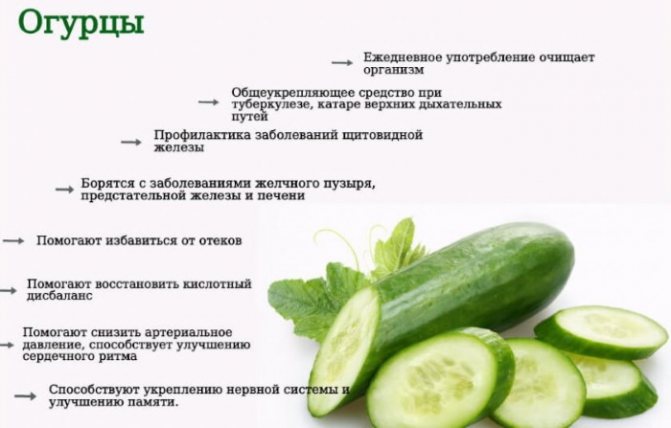
The greatest benefits come from self-grown cucumbers - you can be sure that such vegetables do not contain harmful fertilizers. When using them for food, it is not recommended to remove the skin from them, since this is where most of the useful components accumulate.
The use of vegetables in folk medicine and cosmetology

The fruits and seeds of the plant have a medicinal effect and are widely used in the treatment of many diseases:
- For successful treatment of jaundice and liver diseases, drink a decoction of dry cucumber leaves (20 grams) and fruits (50 grams) four times a day. The raw materials are poured with half a liter of water, boiled for twenty minutes.
- Fever, painful urination, and diseases of the respiratory system are cured with an infusion prepared from cucumber seeds. Taking a tablespoon of crushed seeds, pour three glasses of boiling water. After half an hour, filter the solution and drink a glass three times a day, adding a teaspoon of honey.
- Two to three tablespoons of fresh cucumber juice twice a day with honey is an excellent expectorant for severe coughs. The juice will help get rid of constipation and reduce pain in the stomach and intestines.
- Tuberculosis cough subsides when using cigars rolled from cucumber leaves.
- Crushed greens are applied to skin suffering from rashes and tumors.
In addition to being used in folk medicine, cucumbers are used as a skin whitening agent. Applying pieces of the vegetable to your face every day will make freckles and age spots invisible.
Morning washing or wiping the face with cucumber juice mixed with a water infusion of the peel is used in the treatment of acne. It helps with excessive tanning. The value of the vegetable is not only in its high taste, but also in its medicinal properties.
Harm and contraindications
Cucumber (the benefits and harm to the body also depend on the amount of consumption) is allowed without restrictions only to healthy people, as it has several harmful properties. Because of them, the vegetable is completely contraindicated for some people, while for others it is allowed with restrictions.
The product tends to increase the acidity of gastric juice, which is why it is contraindicated for people with gastritis with high acidity and peptic ulcers of the stomach or intestines. For diarrhea, cucumbers are completely contraindicated, as they improve intestinal motility and only aggravate the problem. If there is a tendency to such a pathology, then the consumption of cucumbers should be limited.
Pregnant women are not recommended to eat too many cucumbers to avoid swelling, which women are already prone to during this period. Nursing mothers should also limit their consumption of cucumbers to a few pieces per week, otherwise the baby may experience diarrhea.
Also, due to the high level of water content, cucumbers are not recommended in large quantities for people with kidney pathologies (since the main function of the kidneys is to remove water from the body, and with a large volume of fluid passing through them, the disease can worsen).
Hypotonics (people with low blood pressure) should limit the consumption of cucumbers, as they tend to lower blood pressure.
Iodine, contained in considerable quantities in cucumbers, can harm people with thyroid pathologies, so you can include the product in your diet only after consulting your doctor.
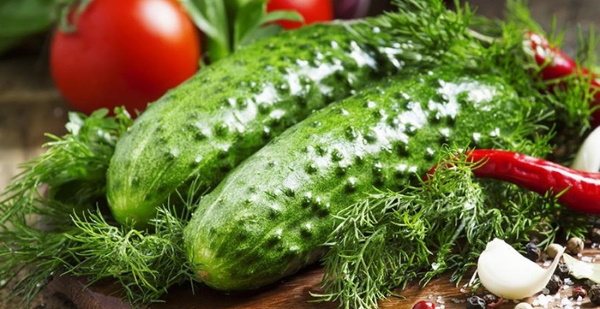
Salted and pickled cucumbers are not recommended for people who have:
- pathologies of the cardiovascular system (since salt causes swelling and increased blood pressure);
- gastrointestinal diseases (brines and marinades additionally irritate the gastric mucosa, aggravating the course of the disease);
- diseases of the biliary system (hepatitis, cholecystitis);
- diseases of the urinary system (pyelonephritis, urolithiasis, renal failure, since salt has an additional negative effect on the kidneys).
Cucumber (the benefits and harm to the body may depend on the time of consumption) should not be eaten in large quantities in the evening - otherwise in the morning you may wake up with swelling due to the accumulation of fluid in the body.
Cucumbers collected in winter and spring can be very harmful to the body, as they contain large amounts of nitrates and fertilizers. Before eating such vegetables, it is necessary to remove the skin and edges from them, since, in addition to useful substances, fertilizers accumulate there.
Conclusion
Cucumber is an annual vegetable grown in almost all countries of the world. The culture is valued for its aromatic unripe fruits (greens), used in cooking, diet therapy, folk medicine and cosmetology. In the food industry, cucumber is used as an independent snack and as part of summer salads, cold soups, and various pickles. Considering that the pulp of the fruit consists of 95% water, cucumber is an integral component of cleansing and detoxifying weight loss programs. Along with liquid, it contains vitamins, minerals, organic acids, tannins, flavonoids, dietary fiber, and adsorbents. The fruits of this crop perfectly satisfy hunger, potentiate the synthesis of thyroid hormones, help reduce swelling, stimulate intestinal contractility, increase the elasticity of blood vessels, and improve the appearance of the dermis.
Source
Menu for PP
Healthy people who have no contraindications should regularly include cucumbers in their diet. You can also arrange a 7-day cucumber diet, which will help cleanse the body, eliminate swelling and lose 2-3 kg by removing fluid. The diet menu does not imply eating cucumbers exclusively for a week and fasting. It allows you to eat a balanced and varied diet.
Monday
Menu:
- Breakfast: smoothie made from cucumber, celery and apple. If the mixture is too thick, you can add a little water to make it easier to drink.
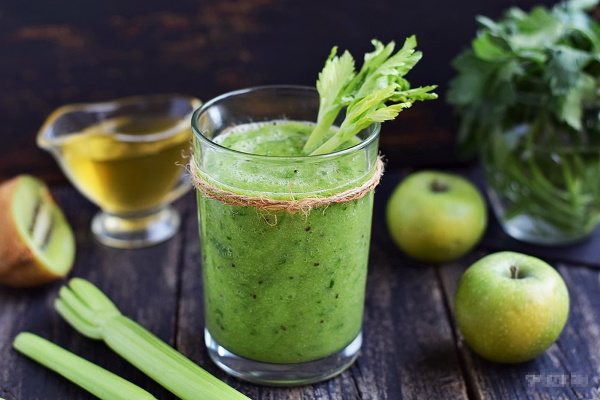
- Snack : any fruit.
- Lunch : any low-fat soup with several pieces of rye bread, for the main course - boiled poultry + any low-fat side dish (buckwheat, rice) + vegetable salad (with the addition of cucumber).
- Afternoon snack : 150 g of cottage cheese or 1 apple or 1 cucumber.
- Dinner : baked low-fat fish with lemon and spices.
Tuesday
Menu:
- Breakfast: rice or buckwheat porridge with water (if desired, you can eat a few pieces of whole grain bread).
- Snack: Sandwich made with whole grain bread, cucumber and cheese.
- Lunch: boiled pasta + steamed chicken cutlet + vegetable salad (optional without adding cucumber).
- Afternoon snack: a glass of kefir or fermented baked milk, or unsweetened fruit.
- Dinner: vegetable salad of tomatoes and cucumbers, sprinkled with vegetable oil.
Wednesday
Menu:
- Breakfast: omelet or scrambled eggs from 2-3 eggs + cucumber salad + a piece of whole grain bread.
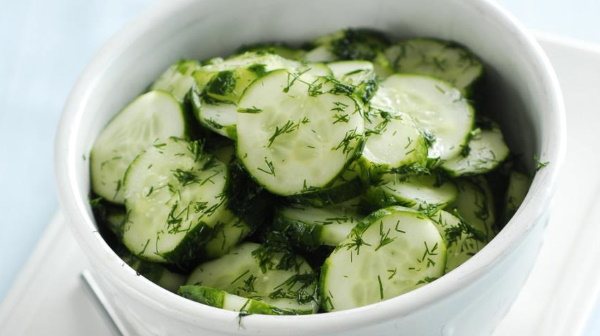
- Snack: 1 orange.
- Lunch: any low-fat soup with several pieces of rye bread; for the main course - boiled rice with baked fish and a salad of cucumbers and herbs.
- Afternoon snack: 10-15 nuts; can be replaced with a small amount of dried fruit.
- Dinner: baked chicken breast with herbs and vegetable salad with cucumbers.
Thursday
Menu:
- Breakfast: Cucumber, celery and apple smoothie.
- Snack: cottage cheese with herbs or a sandwich with whole grain bread, cottage cheese and tomato.
- Lunch: stewed cabbage with bell peppers and beef and cucumber salad.
- Afternoon snack: any unsweetened fruit.
- Dinner: baked red fish with beans, carrots and green peas.
Friday
Menu:
- Breakfast: baked avocado (remove the pit from the avocado, pour a raw egg into the resulting cavity and sprinkle with spices, bake until the eggs are ready) and a salad of fresh vegetables with the addition of cucumber.
- Snack: 1 apple.
- Dinner: for the first course - vegetable soup; for the second course - boiled buckwheat + steamed chicken cutlet + several pieces of rye bread.

- Afternoon snack: Greek yogurt (can be replaced with regular yogurt, but without fruit and berry fillings).
- Dinner: homemade healthy shawarma (smear thin pita bread with sour cream and garlic sauce, top with boiled chicken breast, sliced cucumber, tomatoes, lettuce and pour sauce over everything; lightly fry on the grill).
Saturday
Menu:
- Breakfast: oatmeal with water (can be sweetened with honey).
- Snack: smoothie made from 1 cucumber, 1 kiwi and 1 apple.
- Lunch: boiled chicken or turkey + vegetable side dish.
- Afternoon snack: a small amount of nuts or dried fruits.
- Dinner: steamed egg white omelette + several pieces of whole grain bread + tomato and cucumber salad.
Sunday
Menu:
- Breakfast: spread cottage cheese on whole grain bread, place boiled chicken breast, a slice of cucumber and a slice of low-fat hard cheese on top.
- Snack: yogurt or a glass of fermented baked milk.
- Dinner: baked fish with vegetables.

- Afternoon snack: cucumber salad with vegetable oil.
- Dinner: pasta + minced turkey cutlet.
Recommended drinks include herbal teas and infusions, still mineral water, and berry infusions. It is not recommended to drink too much black tea with sugar or coffee. You need to drink at least 1 liter of clean water per day.
Beneficial features
This fruit can be safely classified as dietary. A lot of people love cucumbers. The composition and nutritional value of this product are ideal for those who want to lose weight. This can be done easily using a cucumber. It can be found in many diets. The composition of cucumber consists of almost only water - 95-98%. The remaining 2-5 percent is occupied by useful substances. Cucumber has a positive effect on the human body:
- Reduces the risk of stones in the kidneys and liver.
- Has a beneficial effect on the heart and blood vessels.
- Improves the functioning of the thyroid gland.
- Has a laxative effect.
- Reduces swelling due to the fact that it can remove excess fluid from the body.
- Slightly reduces blood pressure.
- Cucumber seeds can cleanse the body of cholesterol.
- Has a rejuvenating effect.
- Improves skin color and maintains its tone.
- It has a beneficial effect on the health of teeth and gums.
- Has a slight analgesic effect.
- In folk medicine it is used as a remedy for old coughs.

Fasting day on cucumber
A cucumber fasting day will help you cleanse your body and lose several kilograms in just a day. There are several options for a fasting day with cucumber, so everyone can choose the type of nutrition for themselves.
Only on cucumbers
This is the simplest option for a fasting day: you need to eat 1-1.5 kg of cucumbers per day. Meals should be divided into 5-6 parts, between which you should drink clean still water. Vegetables can be eaten either as a salad or whole.
Cucumber-apple
This fasting day is suitable for those who do not want to eat only vegetables all day. In addition, fruits also contain fiber, which helps normalize digestion. Unloading involves eating 1 kg of cucumbers and 1 kg of apples per day.
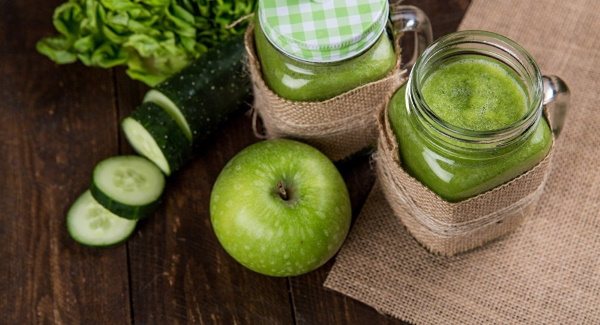
You can prepare a cucumber-apple salad from the products, or eat fresh vegetables and baked fruits. But you need to bake apples without sugar or other additives.
Cucumber-kefir
When choosing this food option, you need to consume 1 kg of vegetables and 1 liter of kefir during the day. Meals should be divided into 5-6 parts, and kefir should be drunk in between. It is also necessary to drink water.
You can make a salad: chop the vegetables and pour a small amount of kefir over them. This salad can be eaten throughout the day or at certain meals (for example, breakfast and dinner).
Cucumber-buckwheat
This food option is very filling - during the day you need to eat steamed buckwheat along with cucumbers.
It is recommended to steam buckwheat, as this allows you to preserve all the beneficial substances inside the grain:
- In the evening, place 250-300 g of cereal in a thermos for food and pour 2 cups of boiling water.
- Close the thermos tightly and insulate it with a towel or blanket.
- Leave the buckwheat to steam overnight.
From the specified amount of buckwheat you will get a large amount of porridge, which needs to be divided into 5-6 doses and consumed together with cucumbers or a salad made from them. For the whole day you will need about 700-800 kg of vegetables. You can also drink green tea without sugar between meals.
On the water Sassi
Sassi water is a drink prepared according to the following recipe:
- Cut a lemon and 2 cucumbers (large size) into circles.
- Tear 10 mint leaves and grate a small amount of ginger root.
- Add all ingredients to 2 liters of clean filtered water and leave to infuse overnight.
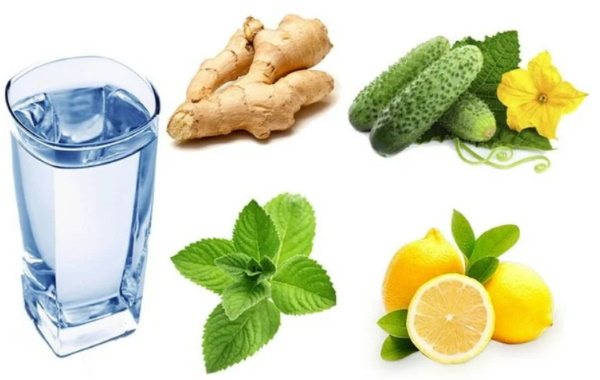
Throughout the next day you need to drink the prepared drink. You can eat cucumbers as a snack. This fasting day option is not suitable for people with problems with the urinary and cardiovascular systems.
A cucumber fasting day can be carried out no more than once every 2-3 weeks, since this type of nutrition is a mono-diet and is not suitable for frequent use.
Product preparation and storage methods

Due to the fact that cucumbers can be preserved in different ways, the vegetable is consumed in salted and pickled form until the next harvest.
- Cucumbers are prepared for the winter by adding dill, horseradish leaves, a head of garlic, blackcurrant, cherry, and oak leaves to jars. Many housewives pour the greens placed in jars three times with hot brine. And others use cold water, and their cucumbers do not spoil under a plastic cover.
- Pickled cucumbers soaked in tomato juice, marinated with carrots, onions and mint leaves are well preserved. There are many cooking recipes, and each housewife has her own special way of preparing vegetables for the winter.
- Storing fresh fruits involves placing them in cold water, coating the skin with egg white, and keeping them in an open plastic bag placed in the refrigerator. These methods will allow you to enjoy the fresh product for a week or two. During storage, it is necessary to frequently inspect the fruits, removing those that begin to rot or deteriorate.
In any form, cucumbers will be a favorite treat for the whole family during the long winter.
More information can be found in the video:
When to expect an effect
Cucumber (the benefits and harm to the body depend not only on the measure, but also on the frequency of use) should be gradually included in your diet - you should not immediately load up on vegetables, as swelling and some other complications may occur.
The effect of regular consumption of this green vegetable will appear in 1-1.5 months. You will notice that digestion has improved, stools have returned to normal, and swelling has disappeared. For people who have any pathologies for which cucumber helps, the effect will not be very pronounced. But in combination with therapeutic recommendations, regular consumption of cucumbers will help improve the health of the body.
When consuming a vegetable on a fasting day, the effect will appear immediately - excess fluid will leave the body, due to which excess volume and weight will be “burned” (in 1 day you can lose from 1 to 3 kg). The body will also feel lighter and digestion will improve. Cucumber grown with the help of chemicals is not only useless for the body, but also harms it .
When buying vegetables, you need to pay attention to the color of the skin - it should be bright green and matte (too dark a color indicates that the product was grown with chemicals, and a shiny surface means that it was rubbed with wax to give it a marketable appearance). It is also recommended to feel the cucumbers - they should be elastic and dense, but not too hard.
Rules for choosing a cucumber
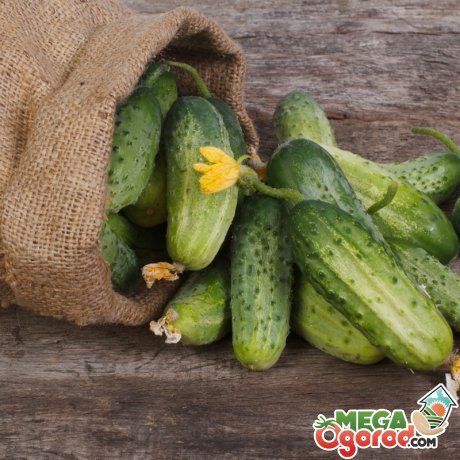
If the plant is grown on the site, then it is collected every day at the same time - in the evening or in the morning. If you skip the procedure, you need to understand that after two days there will be a lot of overgrown fruits in the garden, which prevent new cucumbers from appearing.
When purchasing a vegetable, you must choose firm, bright green fruits that do not have yellow or brown spots.
The size of greens can reach ten centimeters or more. These fruits are good for canning. Longer specimens are used in salads. There is no need to choose fruits that look like a hook or a ball.
If you want to keep greens fresh, then you should not wash them after purchasing. The natural coating will prevent the product from fading. A properly selected vegetable can be kept fresh for several weeks.
Preparation:
- Wash and peel all vegetables. Grate the carrots on a coarse grater, finely chop the onion, and cut the potatoes into cubes. Wash and clean the champignons well, cut them into thin strips.
- Chop the pickled cucumbers into cubes. Pour water into a large saucepan and boil it. Add potatoes, rice, half the onions and carrots to boiling water. Cook everything for 20 minutes.
- Heat a frying pan, pour in vegetable oil. Add the remaining onions and carrots. Simmer vegetables over medium heat for 3 minutes. Add mushrooms and simmer for another 5 minutes, stirring constantly. Add tomato paste and mix everything. Add cucumbers and stir again. Pour some vegetable broth and brine into the pan. Simmer for 5 minutes.
- Place the roast along with the brine into the pan with the vegetables. Add salt and spices. Cover the pan with a lid and cook for 10 - 15 minutes over low heat. Remove the finished pickle from the heat, let the soup brew for 20 minutes.
- Finely chop the greens and add to the pickle. I pour the finished soup into bowls, season with sour cream and serve hot.




